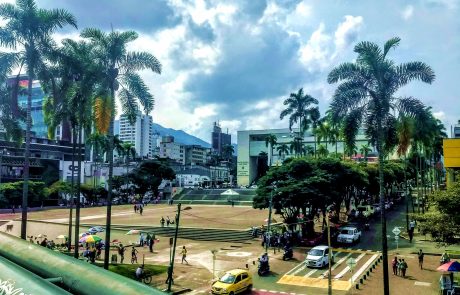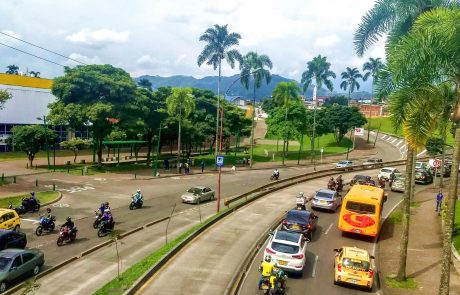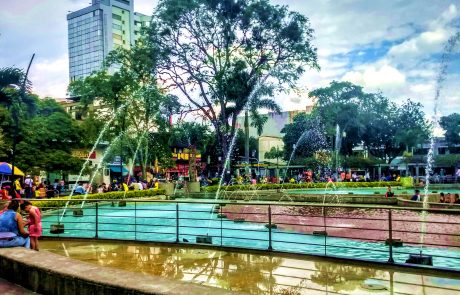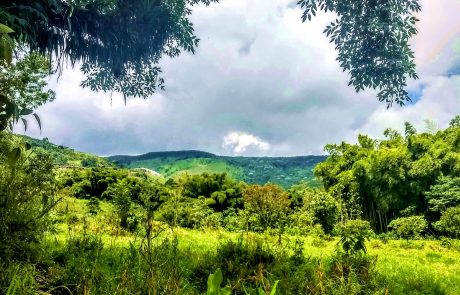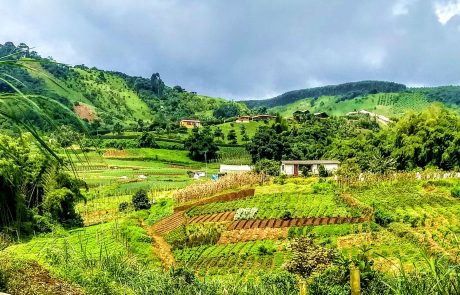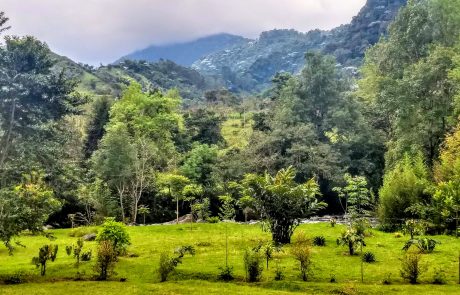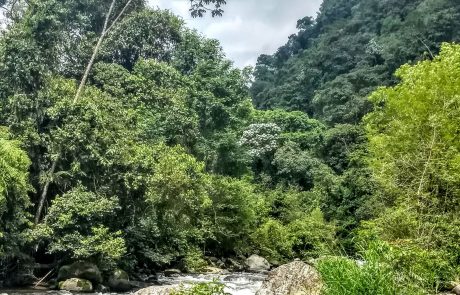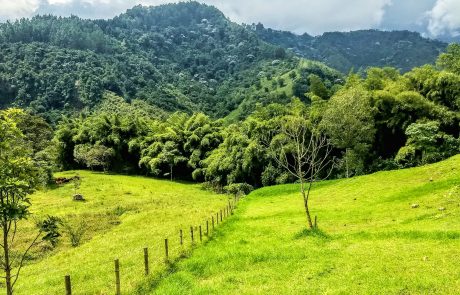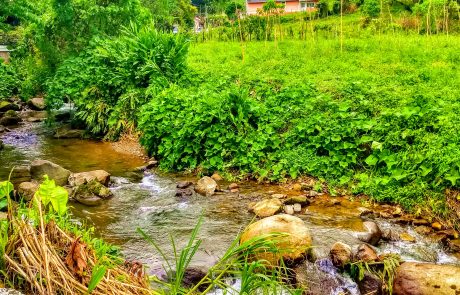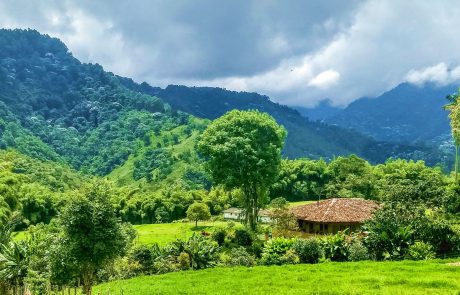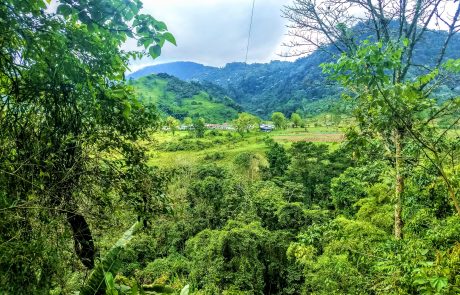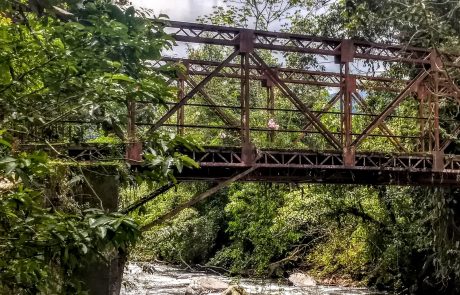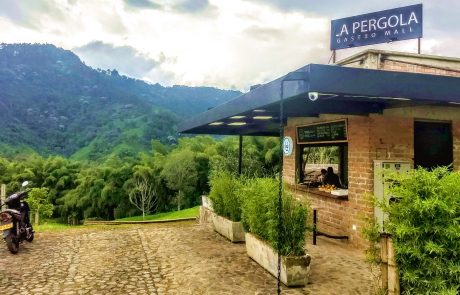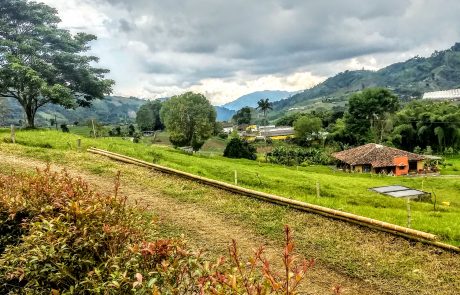June 2019
 At long last I’m in Colombia’s Coffee Triangle, the Eje Cafetero, for a couple months of exploring. My base for the trip is the capital of the region, Pereira. I made it easy on myself for the first few days by holing up in a fancy hotel in what is the equivalent of NYC’s Central Park area, called here Circunvalar. It’s surprising to find such a discrepancy between text and reality in the information available on tourist sites and blogs about Pereira. They give the impression of some sleepy provincial city given over to business concerns, not tourism. Trust me, Pereira is as bustling as any metropolis can be. Businesses may not be open 24/7 like they often are in tourist hotspots, but when they are there’s plenty of traffic. If it were any busier the only word fit to describe it would be “frenetic.”
At long last I’m in Colombia’s Coffee Triangle, the Eje Cafetero, for a couple months of exploring. My base for the trip is the capital of the region, Pereira. I made it easy on myself for the first few days by holing up in a fancy hotel in what is the equivalent of NYC’s Central Park area, called here Circunvalar. It’s surprising to find such a discrepancy between text and reality in the information available on tourist sites and blogs about Pereira. They give the impression of some sleepy provincial city given over to business concerns, not tourism. Trust me, Pereira is as bustling as any metropolis can be. Businesses may not be open 24/7 like they often are in tourist hotspots, but when they are there’s plenty of traffic. If it were any busier the only word fit to describe it would be “frenetic.”
After a few days of the urban life I was dying to get out into the stunning countryside visible everywhere in Pereira. The fourth-floor al fresco restaurant of my hotel brought the surrounding mountains into clear view. One morning as I sat nursing my coffee while looking at the mountains a decision crystallized in my head in the twinkle of an eye: head for the hills. So with the help of a personal guide I’d hired to help me get a handle on the city and life in Colombia (all new to me) off we went to a little town only 5 miles from my hotel but an entire world away with regard to atmosphere. That’s one of the beauties of Pereira, in my opinion. You can find yourself surrounded by swirling traffic while dodging pedestrians on busy sidewalks and — if you manage to find the right bus — you can be in tranquil countryside within half an hour. Perfect!
Mind you, without the guide’s help I’d have got nowhere fast. We walked down streets I’d be hard pressed to identify on the Google map to a small bus lot off a nondescript side street. No amount of charity would induce one to call it a bus terminal, although functionally that’s what it is. It’s a gravel lot with some buses, a few food stalls and some benches. Hard wooden benches, in point of fact. When we got to the bus lot I retraced our steps in my mind and lost the trail long before arriving at my hotel. Without the guide I could never in a million years have found my way to the bus for La Florida. I wouldn’t even have known of its existence. It just goes to show that as a tourist only a small percentage of local resources are at your fingertips, no matter how good you are at doing research on the Internet. I know for a fact that you can search night and day and you’ll never find a clear and concise guide about getting a bus from Pereira to La Florida. My guide, however, wandered through the streets as though it were the easiest thing in the world. It takes the ginger out of you if you’re feeling smug about having figured things out beforehand. I’ve travelled enough by this point to know full well that I’m always going to find myself wearing the dunce cap when it comes to the local ins and outs of travel, so I kept my mouth shut and followed my guide’s directions all the while knowing I’d never reach his level of competence unless I lived in Pereira for years as he’s done. That’s just how it works.
If I’d asked at Reception in my fancy hotel about getting a bus to La Florida, the staff would have gone into a panic, I’m sure. The bus lot is in a part of town that doesn’t see tourists of a certain age wandering about unaccompanied. Had I asked the nice gentleman at the reception desk for directions to walk to the bus he’d have recoiled in horror and said something like, “Oh sir, you can’t go there by yourself!” That’s actually what the guide told me. In such matters I take local wisdom at face value. No need to ask for trouble, is there. So to my guide Andres a hearty round of applause for leading me through the Valley of the Shadow of Tourist Death, although to be honest it looked no worse than some of the neighborhoods I trudged through in the Philippines. We made it in one piece to the bus lot and soon enough found ourselves trundling along the road that follows the River Otun to La Florida.
Just for the sake of contrast, here are a few pics of downtown Pereira, a modern and attractive city. But it’s a city 100 per cent.
As we headed out of town the landscape gradually became visible and entered awareness as the basic item of existence it actually is. That’s easy to forget when you’re cruising around the city looking for lunch or someplace that has dental floss. By the time we arrived at La Florida I was already spellbound by the countryside. The entire road to La Florida follows the Otun River, a rock-strewn thing that looks more like a large creek than what we’d normally call a river in the States. It’s a mountain stream, in effect, coming from the mountains to the east of Pereira. It supplies Pereira with its fine water, which can be consumed directly from the tap. That’s not something most places in Colombia can brag about, so I take it as a Big Deal. It became clearer and clearer to me why that hydrological situation obtains as we neared La Florida. The river looked from the bus as clear as glass, bouncing off the rocks as it rushed down the valley toward the city.
Upon arriving at the town I was struck by how small it is. Just one main street that takes about two minutes to traverse from top to bottom. But there were lovely surprises even in that short space, as this picture shows:
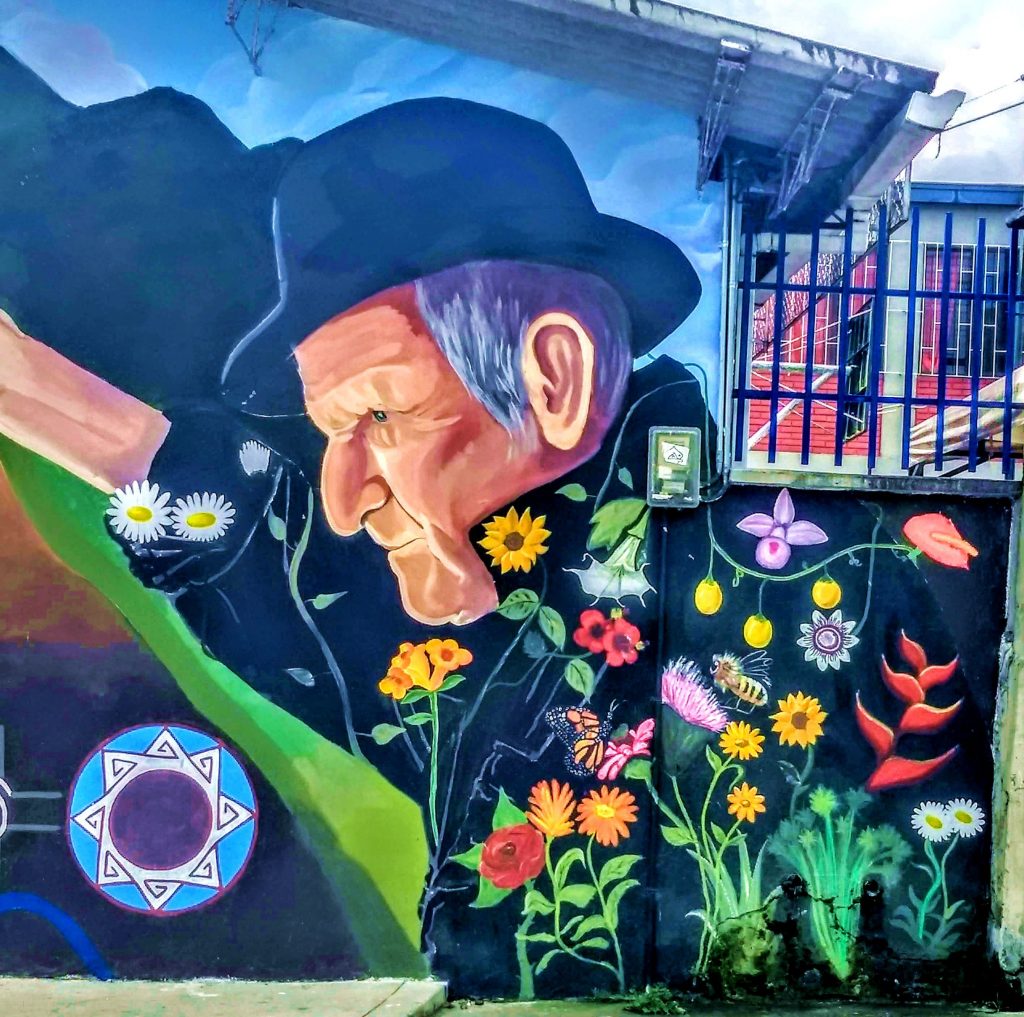
Somebody’s got talent :-).
The walk through the town on the main street soon led us out of the village into the countryside. The sensation of being in the country after having spent three days running around the busy city is easy to recall but has so many facets I’m hard pressed to formulate words to capture the experience succinctly. Andres used the word “tranquilidad” (=calm) repeatedly in describing his own experience. In Spanish it has many layers of meaning and encapsulates such an experience well enough for a native speaker. We English speakers like to break things down into categories and distinguish among them with much greater detail. Calm is certainly one description for the experience, but belies the envigorating effect of being out in the countryside where everything is alive. Colombia is in the top countries of the world for biodiversity, largely due to the astonishing number of ecosystems it contains. The Coffee Triangle is only one of those ecosystems, certainly not as biodiverse as the Amazonas region. Even so, I was astonished at the number of different species I could spot in even a small area of forest. Some of the plants were familiar to me, such as morning glory of the bindweed variety, which we have in my own neck of the woods in the States. The hills were awash with colored trees that I had never before seen in my life and the sight held me spellbound. Time for some more pics to make the point more tangible:
If pictures are worth a thousand words, then the landscape in the pics above deserves its own special language. I’ve seen a lot of landscapes in my long years but the Coffee Triangle is a new kind of landscape for me. The hills are much steeper, there are many more kinds of trees and plants in the scenario and the entire area looks “gardenized.” I have to invent words to capture my impressions, normal ones just won’t do the job. I use “gardenized” because the natural elements and the areas of human cultivation seem very harmonious for reasons I’m at pains to articulate. In many landscapes I find the element of human cultivation invasive or oppressive. Not so in this landscape: it seems that the natural world and the human elements co-exist peacefully and without any grave damage to either participant. An environmental biologist would likely disagree with that interpretation on quite solid scientific grounds, but from an aesthetic viewpoint the harmony is unquestionable. The amount of land under human cultivation doesn’t reduce the natural elements to bits and bobs sticking out like a sore thumb. Neither does the area have the STAY ON PATHS feel that nature reserves have. People are going about their agricultural business and the Planet is doing its own thing, too. No skin off anybody’s nose, that’s how it seems to me. That sense brought a kind of relaxation I’ve known in very few places in the world and when I felt it spreading through me I made a note to self: “BIG DEAL.” I can still sense that feeling rise when I think of the landscape I saw in La Florida. I’m interested to see what sense rises as I continue my exploration of the Coffee Triangle and its different regions.
Surprisingly there were quite modern and very European-style facilities available for the cyclists and walkers. One such place styled itself a “gastromall,” with all four of its small restaurants combining to form this monolith to tourist satisfaction. It’s a lovely place to hang out and have a coffee or lunch. I sat at a seat near an avocado tree sporting a full crop of baseball-sized Hass avocados, a variety apparently only recently introduced into the Coffee Triangle and becoming very popular. The usual variety here is the very large light green type, examples of which I’ve seen in the public market, some of them the size of small melons. For someone from the Bitter North like me, sitting sipping a coffee grown in that very area while hanging out with an avocado tree is a peak experience.
The entire trip took no more than four hours but will last a lifetime in my memory because it represents my first introduction into the natural world of the Coffee Triangle, the very thing that set my sights on this part of the world some months ago. I made the right choice.

